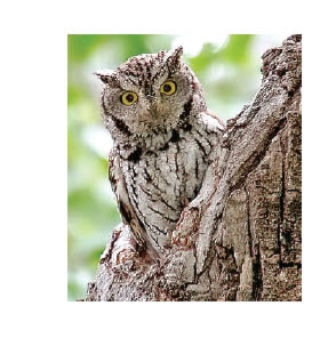During the past few weeks, MARS has seen an unusually high number of wildlife cases, resulting in a “full house.”
The majority of these cases have been large and small raptors — eagles, hawks, and five different species of owls — as well as a number of shore and water birds.
Certainly the wind, rain and snowstorms have all taken their toll on our local wildlife species, especially owls like the Western Screech owl. Three of our owl cases sustained head injuries, and in two cases, this resulted in severe eye injuries.
The Western Screech owl is found from southern Alaska down to the Baja Peninsula in Mexico, and is a small nocturnal owl. These owls prefer open woodlands and forest clearings, but can also be seen in urban parks and orchards.
This owl is approximately 22 centimetres tall with a 52-centimetre wingspan, and weighs approximately 150 grams. There are two species of Screech owl, the Western and the Eastern, and they vary in coloration from one habitat to another.
Their plumage will differ according to the type of habitat they live in: those owls that live in more arid areas will have lighter coloration whereas those that are more forest dwellers tend to have darker plumage. Local populations of Western Screech owls can also vary in coloration, but usually have grey or brown feathers streaked with white and black.
In keeping with owls in general, they have large, forward-facing eyes that are fixed in their sockets — this is why owls have to turn their heads, as they are unable to move their eyes.
Western Screech owls have bright yellow eyes and a black beak, their legs and feet are covered in feathers, and they have short ear tufts which can be raised or lowered. The ear tufts and the ability to elongate their bodies allows them to resemble the horizontal pattern of tree bark, providing them with the perfect camouflage.
One would assume that these owls “screech,” as their name suggests. They do occasionally screech if threatened, along with wails, yelps and barks, but their usual vocalization is a series of accelerating “toots.”
Screech owls are strictly nocturnal and are most active 45 minutes after dusk — this makes them susceptible to injuries, as their hunting time coincides with the “human rush hour.”
These owls have the nickname of “flying wild cats,” since they are ferocious hunters and have been known to capture prey as large as a chicken-sized blue grouse. These masters of disguise will sit and wait, a technique that allows them to perch patiently awaiting their prey, and once it’s located, they drop down upon the unsuspecting prey, rarely having to put forth a chase.
Screech owls are known as opportunistic feeders and have a wide variety of prey that includes rodents, insects, small reptiles and amphibians; they have also been known to wade into shallow water to snag a small fish.
The Screech owl that was treated at MARS was almost certainly hit by a vehicle. Often rodents run along the road edges, dining on morsels of discarded human food thrown from motorists. Unfortunately, many owls are hit as they attempt to capture the rodent.
Owls have only a thin membrane of skin separating their ear from their eye, and any head trauma often results in severe bruising or destruction of the eye. In our owl’s case, the eye is responding well to medication and it is hoped that the owl will be released. Providing the owl’s hearing is not compromised, nocturnal owls can manage with some visual impairment. We have released “one-eyed owls.”
• • •
To report injured wildlife, call our pager at 1-800-304-9968.
Sandy Fairfield is the educational co-ordinator for the Mountainaire Avian Rescue Society (MARS). The MARS column appears every second Friday.
